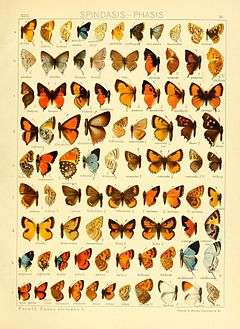Capys disjunctus
| Capys disjunctus | |
|---|---|
 | |
| Scientific classification | |
| Kingdom: | Animalia |
| Phylum: | Arthropoda |
| Class: | Insecta |
| Order: | Lepidoptera |
| Family: | Lycaenidae |
| Genus: | Capys |
| Species: | C. disjunctus |
| Binomial name | |
| Capys disjunctus Trimen, 1895[1] | |
The Russet Protea (Capys disjunctus) is a butterfly of the Lycaenidae family. It is found in from the East Cape to KwaZulu-Natal, inland to Swaziland, Mpumalanga, Gauteng and the Limpopo Province in South Africa. It is also found in Zimbabwe.
The wingspan is 31–37 mm for males and 31.5–38 mm for females. Adults are on wing from August to October and from January to March and sometimes April. There are two generations per year.[2]
The larvae feed on the flower buds of Protea caffra, Protea welwitschii, Protea angolensis, Protea gazensis and Protea petiolaris.
References
| Wikispecies has information related to: Capys disjunctus |
| Wikimedia Commons has media related to Capys disjunctus. |
This article is issued from Wikipedia - version of the 8/17/2014. The text is available under the Creative Commons Attribution/Share Alike but additional terms may apply for the media files.